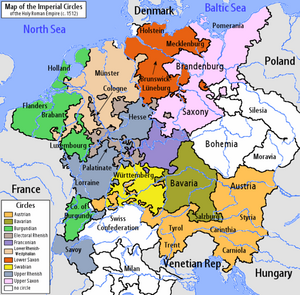Holy Roman Empire
Holy Roman Empire Sacrum Imperium Romanum (in Latin) Heiliges Römisches Reich (in German) | |||||||||||||||||||||
|---|---|---|---|---|---|---|---|---|---|---|---|---|---|---|---|---|---|---|---|---|---|
| 800/962[a]–1806 | |||||||||||||||||||||
 The Holy Roman Empire at its greatest extent in the early to middle 13th century during the Hohenstaufen dynasty (1155–1268) superimposed on modern state borders. | |||||||||||||||||||||
| Capital | No official capital, various imperial seats[b] | ||||||||||||||||||||
| Common languages | German, Latin (administrative/liturgical/ceremonial) Various[c] | ||||||||||||||||||||
| Religion | Roman Catholicism (800–1806) Lutheranism (1555–1806) Calvinism (1648–1806) see details[broken anchor] | ||||||||||||||||||||
| Government | Elective monarchy | ||||||||||||||||||||
| Emperor | |||||||||||||||||||||
• 800–814 | Charlemagne[a] | ||||||||||||||||||||
• 962–973 | Otto I (first) | ||||||||||||||||||||
• 1792–1806 | Francis II (last) | ||||||||||||||||||||
| Legislature | Imperial Diet | ||||||||||||||||||||
| Historical era | Middle Ages Early modern period | ||||||||||||||||||||
• Charlemagne is crowned Emperor of the Romans[a] | 25 December 800 | ||||||||||||||||||||
| 2 February 962 | |||||||||||||||||||||
| 2 February 1033 | |||||||||||||||||||||
| 25 September 1555 | |||||||||||||||||||||
| 24 October 1648 | |||||||||||||||||||||
| 2 December 1805 | |||||||||||||||||||||
• Francis II abdicated | 6 August 1806 | ||||||||||||||||||||
| Population | |||||||||||||||||||||
• 1200 | 5000000[2] | ||||||||||||||||||||
• 1500 | 16000000[3][4] | ||||||||||||||||||||
• 1618 | 21000000[5] | ||||||||||||||||||||
• 1648 | 16000000[5] | ||||||||||||||||||||
• 1786 | 26265000[6] | ||||||||||||||||||||
| |||||||||||||||||||||
The Holy Roman Empire (Latin: Sacrum Imperium Romanum; German: Heiliges Römisches Reich), occasionally but unofficially referred to as the Holy Roman Empire of the German Nation,[7] was a polity in Western and Central Europe under the rule of an emperor, who was elected by the princes and the magistrates of its regions and cities. On 25 December 800, Pope Leo III crowned the Frankish king Charlemagne as Roman emperor and revived the title in Western Europe for the first time since the fall of the ancient Western Roman Empire in 476.
When Charlemagne died in 814, his Frankish Empire was given to his sons and divided into three different countries: West Francia, Lotharingia and East Francia. In 962, Otto I was crowned emperor by Pope John XII. The empire would last for over eight centuries, until it ended in 1806.
At the start of the empire, the emperor was quite powerful. As time went on, however, the empire's duchies and counties became more powerful than the emperor.
Politics
[change | change source]Since Charlemagne, the polity was simply called the Roman Empire.[8] The name "Holy Roman Empire" was not used until the 13th century. Before then, people had called the empire by different names like universum regnum ("the whole kingdom", meaning that it included all regions, not just local kingdoms) and imperium christianum ("Christian empire"). The emperor's right to rule came from the idea of translatio imperii ("transfer of rule"), which meant that he had the highest power, which had been passed down from the Ancient Roman emperors.[9]
The Holy Roman Empire was not very centralized, unlike most countries today. Instead, it was divided into dozens and eventually hundreds of individual entities, which were governed by kings, dukes, counts, bishops, abbots and other rulers, who were collectively known as princes. The emperor directly ruled some areas, but he could not simply issue decrees and govern autonomously over the empire. His power was severely restricted by the various local leaders.
In the 16th century, the empire had to deal with the rebellion of the Frisians, which was led by Pier Gerlofs Donia and Wijerd Jelckama, from 1515 to 1523.
The empire was a rare state in Europe to have an elective monarchy. The emperor was chosen by a small group of prince-electors, but the previous emperor's dynastic heir was commonly elected to the throne. Until 1596 the elected emperor was crowned by the Pope to make him a real emperor. The House of Habsburg ruled most of the time between about 1280 and the end of the empire in 1806.

References
[change | change source]- ↑ Žůrek, Václav (31 December 2014). "Les langues du roi. Le rôle de la langue dans la communication de propagande dynastique à l'époque de Charles IV". Revue de l'Institut Français d'Histoire en Allemagne (in French) (6). doi:10.4000/ifha.8045. Retrieved 6 April 2016.
- ↑ "Atlas of Europe in the Middle Ages", Ostrovski, Rome, 1998, page 70
- ↑ John Pike. "Holy Roman Empire - 1500 - The German Empire".
- ↑ Rabe, Horst (1989). Reich und Glaubensspaltung, Deutschland 1500-1600. C.H.Beck. ISBN 9783406308161.
- ↑ 5.0 5.1 Mansbach, Richard W.; Taylor, Kirsten L. (17 June 2013). Introduction to Global Politics. Routledge. ISBN 9781136517372.
- ↑ Dann, Otto (1993). Nation und Nationalismus in Deutschland, 1770-1990. C.H.Beck. ISBN 9783406340864.
- ↑ Wilson, Peter H. (10 April 2016). Heart of Europe: A History of the Holy Roman Empire. Harvard University Press. ISBN 9780674058095 – via Google Books.
- ↑ Wilson 1999, p. 2.
- ↑ Whaley 2012a, pp. 17–21.
Notes
[change | change source]- ↑ 1.0 1.1 1.2 Some historians refer to the beginning of the Holy Roman Empire as 800, with the crowning of Frankish king Charlemagne considered as the first Holy Roman Emperor. Others refer to the beginning as the coronation of Otto I in 962.
- ↑ The Empire had no official capital, though there were a number of imperial seat cities, which varied throughout history: e.g. Vienna (Continuous Imperial Residenz City, 1483–1806), Regensburg (Eternal Diet, 1663–1806) and Prague (1346–1437, 1583–1611)
- ↑ German, Low German, Italian, Czech, Polish, Dutch, French, Frisian, Romansh, Slovene, Sorbian, Yiddish and other languages. According to the Golden Bull of 1356 the sons of prince-electors were recommended to learn German, Latin, Italian and Czech.[1]
Other websites
[change | change source]![]() Media related to Holy Roman Empire at Wikimedia Commons
Media related to Holy Roman Empire at Wikimedia Commons


